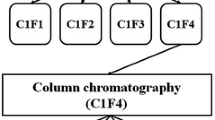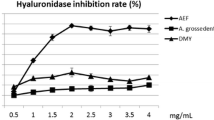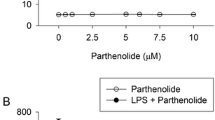Abstract
Drugs which block the biosynthesis of leukotrienes and prostaglandins may have potential in the treatment of psoriasis and other skin diseases. The biochemical and anti-inflammatory activity of 9-phenylnonanohydroxamic acid (BMY 30094) is described. BMY 30094 inhibited human neutrophil 5-lipoxygenase with an IC50 of 5.7 μM. BMY 30094 also blocked human platelet cyclooxygenase and lipoxygenase with IC50 values of 15.2 and 15.0 μM, respectively. Topical application of this compound blocked arachidonic acid and 12-O-tetradecanoylphorbol ester-induced mouse skin inflammation with activity comparable to that observed for lonapalene. The topical ED50 for BMY 30094 in the arachidonic acid-induced inflammation model is 2.2 μmoles/ear. In the sub-cutaneous carrageenan sponge assay in rats, BMY 30094 blocked LTB4 and PGE2 production and inhibited neutrophil migration. This compound would be a useful tool to determine the role of arachidonic acid metabolites in the etiology of inflammatory dermatoses.
Similar content being viewed by others
References
K. Kragballe and J. J. Voorhees,Arachidonic acid and leukotrienes in dermatology. J. Invest. Dermatol.81, 293–296 (1983).
G. A. Higgs, R. J. Flower and J. R. Vane,A new approach to anti-inflammatory drugs. Biochem. Pharmacol.28, 1959–1961 (1979).
S. Hammarstrom, M. Hamberg, B. Samuelsson, E. A. Duell, M. Stawiski and J. J. Voorhees,Increased concentrations of non esterified arachidonic acid, 12 l-hydroxy-5,8,10,14-elycosatetraenoic acid, prostaglandin E 2 and prostaglandin F 2 in epidermis of psoriasis. Proc. Natl. Acad. Sci. USA72, 5130–5134 (1975).
S. Brain, R. Camp, P. Dowd, A. K. Black and M. Greaves,The release of leukotriene B 4-like material in biologically active amounts from the lesional skin of patients with psoriasis. J. Invest. Dermatol,83, 70–73 (1984).
R. M. Barr, E. Wong, A. I. Mallet, L. A. Olins, and M. W. Greaves,The analysis of arachidonic acid metabolites in normal, uninvolved and lesional psoriatic skin. Prostaglandins28, 57–66 (1984).
N. A. Soter, R. A. Lewis, E. J. Corey and K. F. Austen,Local effects of synthetic leukotrienes in human skin. J. Invest. Dermatol.80, 115–119 (1983).
C. N. Ellis, J. D. Fallon, J. L. Heezen and J. J. Voorhees,Topical indomethacin exacerbates lesions of psoriasis. J. Invest. Dermatol.80, 362 (1983) (Abstract).
K. Kragballe and J. J. Voorhees,Arachidonic acid in psoriasis. Pathogenic role and pharmacological regulation. Acta. Derm. Venereol.120 (Suppl), 12–17 (1986).
A. Lassus and S. Forsstrom,A dimethoxynaphthalene derivative (RS-43179 gel) compared with 0.025% fluocinolone acetonide gel in the treatment of psoriasis. Br. J. Dermatol.113, 103–106 (1985).
R. Camp, A. K. Black, F. Cunningham, A. Mallet and M. Greaves,Pharmacological effects of topical lonapalene in psoriasis. J. Invest. Dermatol.90, 550 (1988) (Abstract).
A. Boyum,Isolation of lymphocytes, granulocytes and macrophages. Scand. J. Immunol.5 (Suppl 5), 9–15 (1976).
W. Boyle,An extension of the 51 Cr-release assay for the estimation of mouse cytotoxins. Transplantation6, 761–764 (1968).
E. E. Opas, R. J. Bonney and J. L. Humes,Prostaglandin and leukotriene synthesis in mouse ears inflamed by arachidonic acid. J. Invest. Dermatol.84, 253–256 (1985).
J. M. Young, B. M. Wagner and D. A. Spires,Tachyphylaxis in 12-O-tetradecanoylphorbol acetate- and arachidonic acid-induced ear edema. J. Invest. Dermatol.80, 48–52 (1983).
A. Janoff, A. Klassen and W. Troll,Local vascular changes induced by the cocarcinogen, phorbol myristate acetate. Cancer Res.30, 2568–2571 (1970).
R. P. Carlson, L. O'Neill-Davis, J. Chang and A. J. Lewis,Modulation of mouse ear edema by cyclooxygenase and lipoxygenase inhibitors and other pharmacologic agents. Agents and Actions17, 197–204 (1985).
T. Nakadate, S. Yamamoto, E. Aizu and R. Kato,The inhibition of 12-O-tetradecanoylphorbol-13-acetate-induced increase in vascular permeability in mouse skin by lipoxygenase inhibitors. Jpn. J. Pharmacol.38, 161–168 (1985).
M. Gschwendt, G. Furstenberger, W. Kittstein, E. Besemfelder, W. E. Hull, H. Hagedorn, H. J. Opferkuch and F. Marks,Generation of the arachidonic acid metabolite 8-HETE by extracts of mouse skin treated with phorbol ester in vivo; identification by 1 H-n.m.r. and GC-MS spectroscopy. Carcinogenesis7, 449–455 (1986).
J. A. Salmon, P. M. Simmons and S. Moncada,The effects of BW755C and other anti-inflammatory drugs on eicosanoid concentrations and leukocyte accumulation in experimentally-induced acute inflammation. J. Pharm. Pharmacol.35, 808–813 (1983).
J. M. Young, D. A. Spires, C. J. Bedord, B. Wagner, S. J. Ballaron and L. M. DeYoung,The mouse ear inflammatory response to topical arachidonic acid. J. Invest. Dermatol.82, 367–371 (1984).
A. Blackham, A. A. Norris and F. A. Woods,Role of neutrophils and arachidonic acid metabolites in experimental models of ear inflammation in mice. Br. J. Pharmacol.86, 786P (1985).
E. C. Arner, B. L. Rule, M. S. Rudnick and W. Galbraith,Arachidonic acid-induced ear edema: correlation of swelling with production of lipoxygenase products. Agents and Actions16, 600–601 (1985) (abstract).
K. Kragballe, L. Desjarlais and J. J. Voorhees,Leukotrienes B 4,C 4 and D 4 stimulate DNA synthesis in cultured human epidermal keratinocytes. Br. J. Dermatol.113, 43–52 (1985).
L. Levine,Arachidonic acid transformations in tumor promotion. Adv. Cancer Res.35, 49–79 (1981).
G. Furstenberger, H. Richter, N. E. Fusenig and F. Marks,Arachidonic acid and prostaglandin E 2 release and enhanced cell proliferation induced by the phorbol ester TPA in a murine epidermal cell line. Cancer Lett.11, 191–198 (1981).
C. L. Ashendel and R. K. Boutwell,Prostaglandin E and F levels in mouse epidermis are increased by tumor-promoting phorbol esters. Biochem. Biophys. Res. Commun.90, 623–627 (1979).
G. Furstenberger and F. Marks,Prostaglandins, epidermal hyperplasia and skin tumor promotion. InProstaglandins, Leukotrienes and Cancer vol. 3 (Eds. K. Honn and L. J. Marnett), Arachidonic acid metabolism and tumor promotion (Eds. S. M. Fischer and T. J. Slaga), pp 49–72, Martinus-Nyhoff, Boston 1985.
A. Crummey, G. P. Harper, E. A. Boyle and F. R. Mangan,Inhibition of arachidonic acid-induced ear oedema as a model for assessing topical anti-inflammatory compounds. Agents and Actions20, 69–76 (1987).
G. A. Higgs, R. L. Follenfant and L. G. Garland,Selective inhibition of arachidonate 5-lipoxygenase by novel acetohydroxamic acids: effects on acute inflammatory responses. Br. J. Pharmacol.94, 547–551 (1988).
S. J. Foster, M. E. McCormick, A. Howarth and D. Aked,Leukocyte recruitment in the subcutaneous sponge implant model of acute inflammation in the rat is not mediated by leukotriene B 1. Biochem. Pharmacol.35, 1709–1717 (1986).
R. Roncucci, G. Lambelin, M. J. Simon and K. Debast,In vitro action of bufexamac and selected hydroxamic acids on isolated rat liver lysosomes. Arch. Int. Pharmacodyn. Ther.203, 348–367 (1973).
G. Orzalesi, R. Selleri, O. Caldini, I. Volpato, F. Innocenti, J. Colome, A. Sacristan, G. Varez and G. Pisaturo,Determination of Ibuproxam and its metabolites in the plasma and urine of rats. Arzneim-Forsch27(I), 1012–1015 (1977).
Author information
Authors and Affiliations
Rights and permissions
About this article
Cite this article
Tramposch, K.M., Zusi, F.C., Marathe, S.A. et al. Biochemical and pharmacological properties of a new topical anti-inflammatory compound, 9-phenylnonanohydroxamic acid (BMY 30094). Agents and Actions 30, 443–450 (1990). https://doi.org/10.1007/BF01966310
Received:
Accepted:
Issue Date:
DOI: https://doi.org/10.1007/BF01966310




